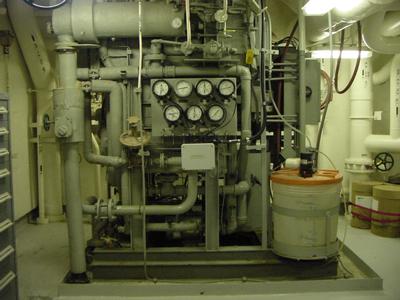4 September, 2001
September 4, 2001
A Clean Ship Is a Happy Ship
The Healy has been at sea for over a month now. Perhaps you are wondering
how the ship manages to stay clean and fresh. This is quite an interesting
story (at least to me).
First I must tell you that there are international guidelines and laws
regarding the disposal of wastes produced by ships, but they aren't strict
compared to laws on land.
When a ship is in port, the regulations require that no waste of any kind be
put over the side. However, once you leave port and are 3 miles beyond
land, that changes. At the 3-mile point, "gray" water and "black" water can
be pumped over the side. Gray water is water that is used in sinks and
showers throughout the ship, and black water is water used in toilets.
After a ship reaches 25 miles beyond shore, the regulations become very
loose. Items that may be thrown over include paper, cardboard, wood, metal,
and glass! The guidelines require that these items be cut or broken into
certain sized pieces. The only material restricted from being dumped
overboard is plastic.
So how does the Healy manage this situation? The Healy does a great job and
is more conservative than the regulations allow. The trash that we produce
is dealt with by using separate cans for different types of trash. One set
of cans is for burnable garbage. The garbage produced in these cans is
burned in the ship's incinerator. The incinerator, lovingly named "Egor",
runs 24 hours a day to keep up with the supply that is created and is fueled
by waste oil produced by the ship's operation.
Another set of cans exists for non-burnable trash. This would include items
such as chemicals, metal, and batteries. This type of trash is stored in a
"holding van" and returned to port for disposal.
A third set of cans exists for food-related garbage. The leftovers and
anything food-related, such as apple cores and coffee grounds, goes in these
cans. It is then ground up in a disposal and put over the side.
The Healy makes a large effort to reduce and reuse when at sea. We are
asked to be diligent in placing garbage in the proper cans. We are also
asked to be conscious of our water usage and take "sea showers". This means
that you turn off the water when lathering up, then turn it back on to
rinse. You might imagine that the supply of water is endless at sea, but
this isn't so. When seawater is pumped on board and distilled to make fresh
water, it requires time and energy. Although the distillers boil saltwater
and collect the steam to make about 5,000 gallons per day, some days we use
more than is created. We are then made aware of the problem and work
together in an effort to solve it.
A clean ship is a happy ship, and we aboard the USCGC Healy are happy
indeed.

<> Saltwater is made into usable, fresh water here.

This small incinerator (Egor) can handle a large load, as crewmember Brandon Schreck demonstrates. <>
Contact the TEA in the field at
.
If you cannot connect through your browser, copy the
TEA's e-mail address in the "To:" line of
your favorite e-mail package.
|
